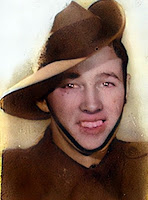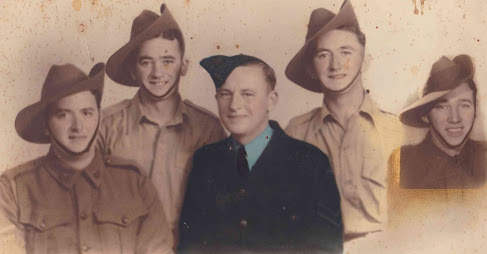.jpg) |
| 5 Star Female Relative Badge |
“How brave she was
letting five sons go off to war!” my cousin Fiona said. And our Nana Barrett
was brave but as I discovered, many things were completely beyond her control.

Florence May Barrett A157977
Recipient of Female Relative Badge World War II
We had heard the story
from my mother that Dad wanted to enlist when he was 17 but Nana put her foot
down and forbade it. “I’ve already got four boys in this war. You’re not going.”
But when Dad returned home from work on his 18th birthday there was
the letter waiting for him on the dining room table instructing him to report
for duty. It must have broken Nana’s heart. Nana had seven boys and one girl
and by December 1942 all the boys over 18 were serving in the armed forces. One
had volunteered and four had been conscripted. Two years later it was only the
occupation in essential services of her sixth son that saved him from having to
enlist. And the seventh son was still only 17. How could a country ask so much from one family?
| The Barrett boys serving overseas L to R: Jack b1913, Gordon b1916,Rowley b1914, Stan b1920 and Dudley b1924 |
At the outbreak of the war Australia's military forces were seriously depleted. Australia's regular army comprised only 3,000 men.
On 20
October 1939 Prime Minister Robert Menzies announced the reintroduction of
compulsory military training with effect from 1 January 1940. The arrangements
required unmarried men turning 21 to undertake three months’ training with the Citizen
Military Forces (CMF).
In
November 1939 Menzies announced that the existing reserve force, the CMF (or Militia), would be bolstered by conscription. However the CMF would not be
required to fight beyond Australia and its territories, which did include Papua
and New Guinea.
At the
same time, the government raised a new volunteer army for service overseas.
This was the Second Australian Imperial Force (AIF).
It was
the result of a concerted recruitment campaign, though with unemployment being
so high the government had little trouble filling the ranks.

Leading Aircraftsman Rowley
David Winsall Barrett VQ25055
Rowley was the first of
the Barrett boys to enlist in the armed forces. Like many of the men after the
Depression he was unemployed. He had been working for his father as a
bookmaker’s clerk and helping his father with training the horses but although
he had done well at school he had failed to find a secure job. He had
seen the persuasive ads for the Air Force and also wanting to ‘do his duty’ applied
to join the Air Force on 30 April 1940.
Rowley served with No. 3 Squadron in the Middle East.
 |
| Private Stanley Leslie Barrett QX55575 |
At the start of World War II in 1939 all unmarried men aged 21 were to be called up for three
months' military training and Stan completed two lots of training at camps in
Yeppoon in September 1940 and again in March 1941.
Stan was then called up for full time duty with the CMF on 17 December 1941.
Volunteers with the AIF initially scorned CMF conscripts as "chocolate soldiers", or "chockos", because they were
believed to melt under the conditions of battle. However several CMF Militia
units fought under difficult conditions, suffered extremely high casualties in
1942 and distinguished themselves by slowing the Japanese advance on the Kokoda
Track in New Guinea. In an
effort to bolster the ranks of those able to fight overseas, government policy changed to allow the transfer of many of the CMF conscripts to the AIF.
Stan disembarked in Milne Bay on 22 March 1943 and during his
time in New Guinea was transferred to the AIF on 9 July 1943. Stan served with the
42nd Battalion. He served in New Guinea and the Solomon Islands.
 |
| Corporal Gordon Vivian Barrett QX33639 |
During 1940 Gordon completed his three months compulsory training
with the 11 Field Ambulance. He was subsequently called up for
full time duty enlisting on 21 January 1941 and transferring to the 10 Fortress
Company. He was then transferred from the CMF to the AIF on 30 July 1942.
Gordon served as a nursing orderly with the Army Medical
Corps on Thursday Island.

Corporal John Edwin Fitzroy Barrett
QX55352
Jack joined the Volunteer Defence Corps (VDC) on 19 May 1941 and was promoted to Sergeant. He was conscripted into the CMF on 23 May 1942 with the rank of Private and embarked for New Guinea with the 57/60 Battalion on 16 May 1943. He was later transferred to the AIF on 6 July 1943 and promoted to Corporal.
When scrub typhus nearly took his life in May 1944 Jack was repatriated back to Australia where he was transferred to the military police.

Private Dudley Alan Barrett
Q267610
By
mid-1942 all men aged 18–35 and single men aged 35–45 were required to
join the CMF.
Dudley (my Dad) was conscripted on his 18th birthday and ordered to report for duty. On 18 December 1942 he enlisted in the Australian Military Forces (AMF) and was assigned to the 133 Brigade Workshops.
Dad worked as an armourer and served in New Guinea.
At the end of August 1943 a parcel arrived for Nana from the Queensland Lines of Communication Area Records Office containing a 4 Star Female Relative Badge and a form for my Nana to sign and return for receipt of the badge. This form is attached to Gordon’s war record.
Then in
the following year the replacement badge with 5 stars arrived acknowledging the
fifth son. This letter (below) is attached to Dudley’s war record.
 |
| Letter attached to Dudley Barrett's war record accompanying the 5 Star Badge |
When asked
how Nana coped with her boys fighting overseas my Uncle Ken describes his
mother as a stoic. “She was brave in how she handled it all.” He also told of
the close bond that developed over this time between his mother and her
daughter Gloria who was her constant support.
Fate smiled on my Nana and all of her five sons returned, at least visibly unscathed, in dribs and drabs from the awful conflict.
Gordon was the first to return in January 1944, a few months before his younger brother Dudley disembarked in Lae to begin his tour of duty overseas. Rowley was discharged in October 1945 and then his brother Jack the month after that. Young single men were the last to be discharged with Stan arriving home in April 1946 and finally Dudley in September of the same year.
Female Relative Badges were issued to the nearest female relative of those on active service overseas during the First and Second World Wars. They were worn by the wives, mothers, or the nearest female relatives of service personnel. The stars represented the number of relatives involved in the war effort.
One of my cousins is the family custodian of our Nana’s 5 Star Badge and has had it framed with photos of Nana and her five boys who went to war. It was seeing this beautifully framed picture recently that gave me the impetus to write this story.
 |
| Florence May Barrett with her five sons and her 5 Star Badge. Photo courtesy of my cousin |
Acknowledgements:
A big thankyou to my Uncle Ken Barrett who gave me an understanding of the family logistics, the dynamics of what was happening in the family and the local history of the time.
And to my brother-in-law Peter Allen who is my guiding light on all things military my continuing gratitude.
Thanks also to my cousin for preserving the 5 Star Badge and giving it pride of place for future generations to see.
References:
Female Relative Badge | Australian War
Memorial (awm.gov.au)
https://en.wikipedia.org/wiki/Conscription_in_Australia


























